Geneva is one of Switzerland’s most famous cities, thanks to its ties to global diplomacy and the United Nations. This name recognition tends to put Geneva on tourists’ radars, even if they don’t know what to expect from a visit there. Fortunately, the city has an interesting mix of things to do and see.
Three days is generally the best amount of time to spend in Geneva for a full experience of the city. It’s also best to follow a detailed Geneva itinerary if you really want to get the most out of your visit. With our itinerary, you’ll learn about all the best places to visit in Geneva so that you can plan accordingly and not feel like you’re missing out on anything. By the end, you’ll know precisely what to do in Geneva in three days for an entertaining and memorable trip.
Best Time to Visit Geneva
Timing is always an important factor in a trip, so think strategically about when you’ll visit Geneva. Weather and tourist numbers can have a major impact on your trip, affecting the best times to be out sightseeing or the price of accommodations. There’s usually a trade-off between these points, so you’ll need to decide which is more important to you.
The best time to visit Geneva is typically June through September, when the weather is warmest. Summer weather in Geneva is usually pretty mild, which makes it especially pleasant for sightseeing. Of course, that also makes this time of year quite popular with tourists, so you can expect high rates and greater demand for accommodations.
To avoid the summer crowds, you may want to go between September and November instead. The autumn weather is still nice enough for sightseeing outdoors, and hotel rates are a little more reasonable.
Then there’s the matter of coming to Geneva during winter. This is actually one of the busiest and most expensive times to travel there, as tourists flock to the region for skiing. Also, the weather from December through March is sure to be cold and snowy, which isn’t ideal for general sightseeing. Essentially, winter is only a good time to go to Geneva if the main draw for you is skiing or the L’Escalade Festival, which is quite a fascinating historical and cultural event in December.
How to Get Around Geneva
When visiting Geneva, you’ll need to explore different parts of the city in order to see some of its highlights. To reach all these neighborhoods, you need to know the best ways to get around Geneva. While it’s possible to walk between attractions in the city center and by the waterfront, other areas of interest are simply too far apart to travel between them on foot.
Fortunately, Geneva has a great promotion for its public transport. If you stay in a hotel or youth hostel or at a campsite, you get a free Geneva Transport Card to use across the public transport network for the duration of your stay. This makes exploring Geneva an easy, stress-free experience that also saves a little money.
Geneva’s public transport network consists of trams, buses, trains, and yellow taxi boats known as Mouettes. The most useful mode of transport for this itinerary is the city’s trams, which cover much of the greater Geneva area. CERN and Carouge are particularly easy to reach by tram.
If you’re flying to Geneva, it helps to know in advance how to get from Geneva Airport into the city center. The city also has a promotion for tourists here: You’ll receive a free 80-minute ticket for travel into the city on all public transport. The train and the bus are both options, but the train is quicker, taking only six minutes to reach Geneva’s central train station from the airport. From there, it should be simple to catch other transport to your lodgings.
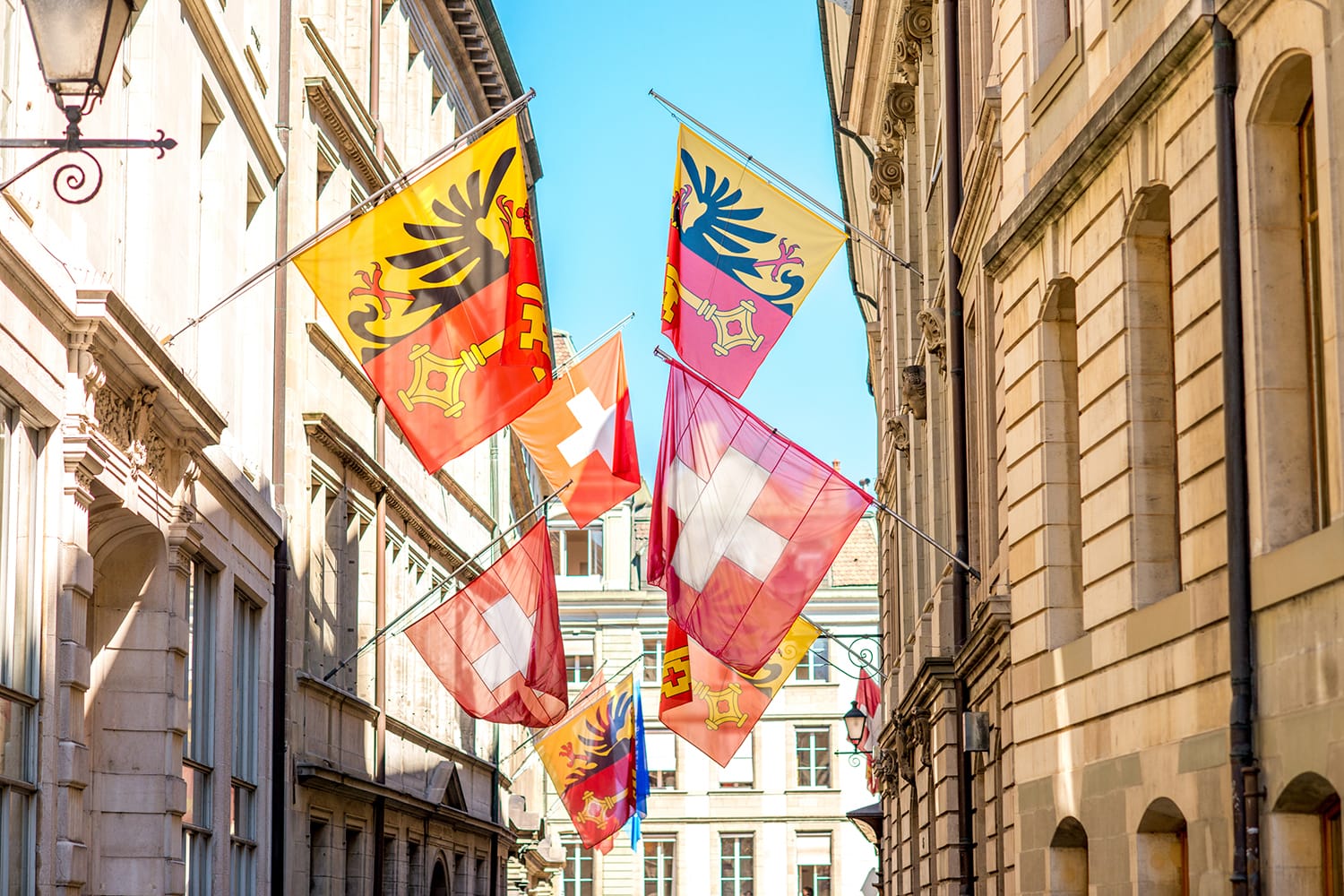
Where to Stay in Geneva
Where to stay in Geneva may well be the hardest decision in planning your visit. It’s always hard to work out accommodations in a place you haven’t been, as you don’t know which hotels are best, where the attractions are, or what the neighborhoods are like.
Luckily, finding the best places to stay in Geneva isn’t that tricky. With the free Geneva Transport Card, it doesn’t really matter how close you stay to the main sights, as you can still get to them easily enough and for free. A central location is nearly always more convenient, though, so consider staying somewhere in or near the Old Town, or between Geneva Cornavin Station and the waterfront.
For a luxurious stay you won’t soon forget, look no further than the Hotel d’Angleterre. This five-star hotel right on the lakefront features refined rooms and suites, plus a restaurant and bar.
For more of a balance between comfort and affordability, Hôtel Bel’Espérance is a straightforward midrange pick in the city’s historic center. Besides an excellent location, this three-star hotel boasts complimentary breakfast and friendly staff.
Budget accommodations are hard to find around the city, with Geneva Hostel being the most affordable option that doesn’t sacrifice quality. This hostel offers clean, simply furnished dorm beds and private rooms, as well as free breakfast.
Another great option for quality accommodations is Airbnb, as it generally offers a wider range of price points and lodging types than hotels.
For more accommodation options in Geneva, check out Booking.com. This site consistently offers the best rates, and its customer service is on point.
The Perfect 3-Day Geneva Itinerary
You’ll have no trouble staying busy for a few days in Geneva. To see the best of Geneva, though, you’ll need to venture a little farther out than you would in most other cities. This will take you well beyond the city center, but that’s what it takes to cover all the best things to do in Geneva. If you follow this guide, you’ll even have time for a day trip to see what else the region has to offer.
However, before we get to our Geneva itinerary, we just wanted to remind you to purchase travel insurance. You never know what will happen and, trust us, you do not want to get stuck with thousands of dollars in medical bills. As a wise man once said, “If you can’t afford travel insurance, you can’t afford to travel.” So don’t leave home without it.
SafetyWing offers travel insurance for only about $10 a week, making it a no-brainer to get. You can get a quick, non-binding quote below:

SafetyWing is, of course, not the only option available. Two other popular alternatives are World Nomads and Heymondo.
With that important subject covered, we can now focus on our Geneva travel itinerary that shows you what to do there. This is our advice on how to make the most of your three days in Geneva and experience the best of the city.
Day 1 in Geneva
When you arrive in Geneva, start with the historic center of the city to see the more traditional attractions.
Recommendation: Make the most of your time in the city with the Geneva Pass. You’ll receive free offers, preferential rates, great discounts, and surprise gifts at over 40 of Geneva’s best attractions, including museums, cruises, and guided city tours.
Old Town
As is so often the case in European cities, the best place to begin in Geneva is the Old Town. While not as extensive or consistent as other historic centers in Europe’s big cities, the Geneva Old Town is a joy to explore, full of historical hallmarks like cobblestone streets, fountains, and old-fashioned architecture.
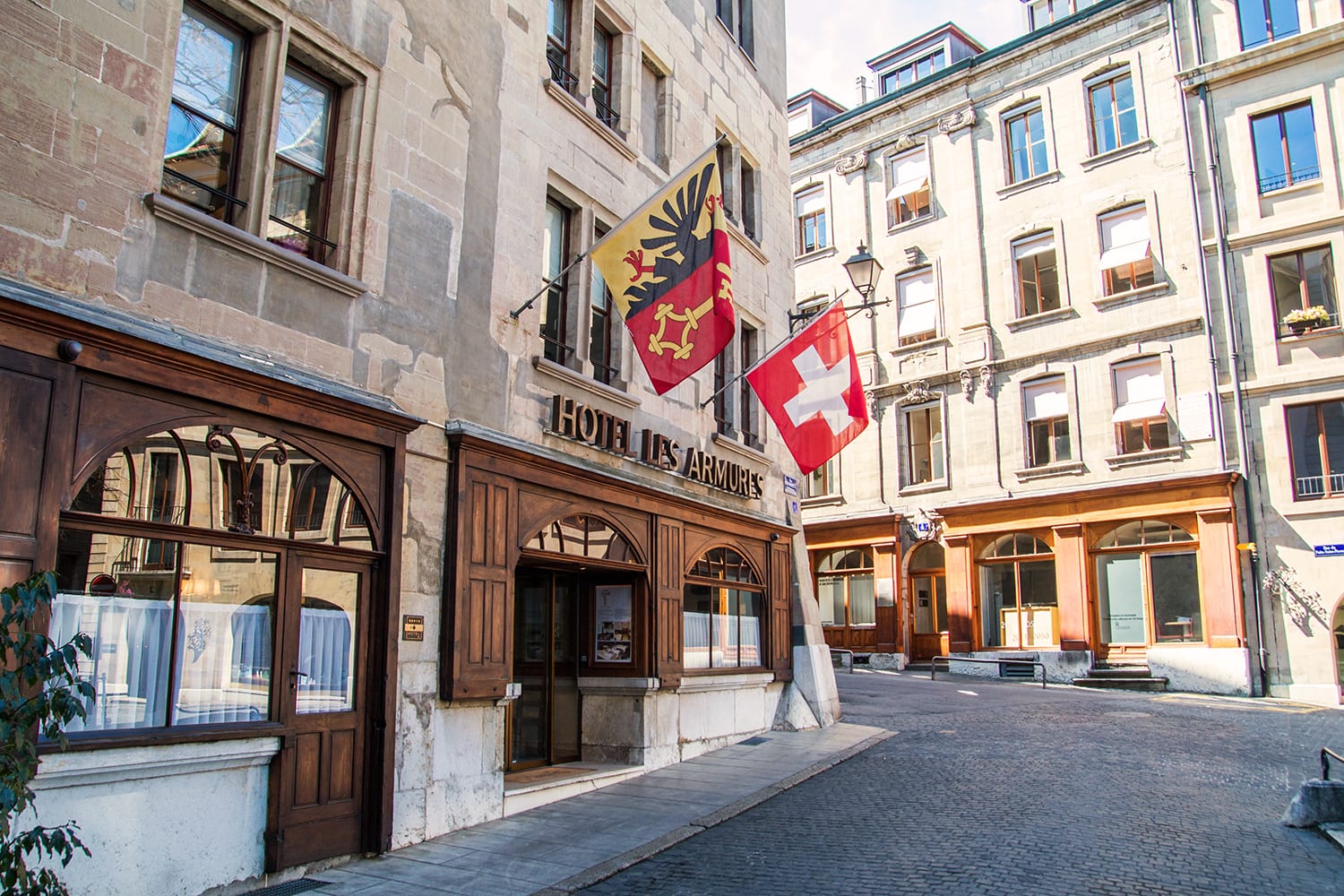
There are some unique touches here too, such as the L’horloge Fleurie, a floral clock in the Jardin Anglais waterfront park. There are also copious independent and upscale boutiques that make shopping the primary activity for many Old Town visitors. Head for the Rue du Rhône if you want to window-shop the most luxurious spots in town.
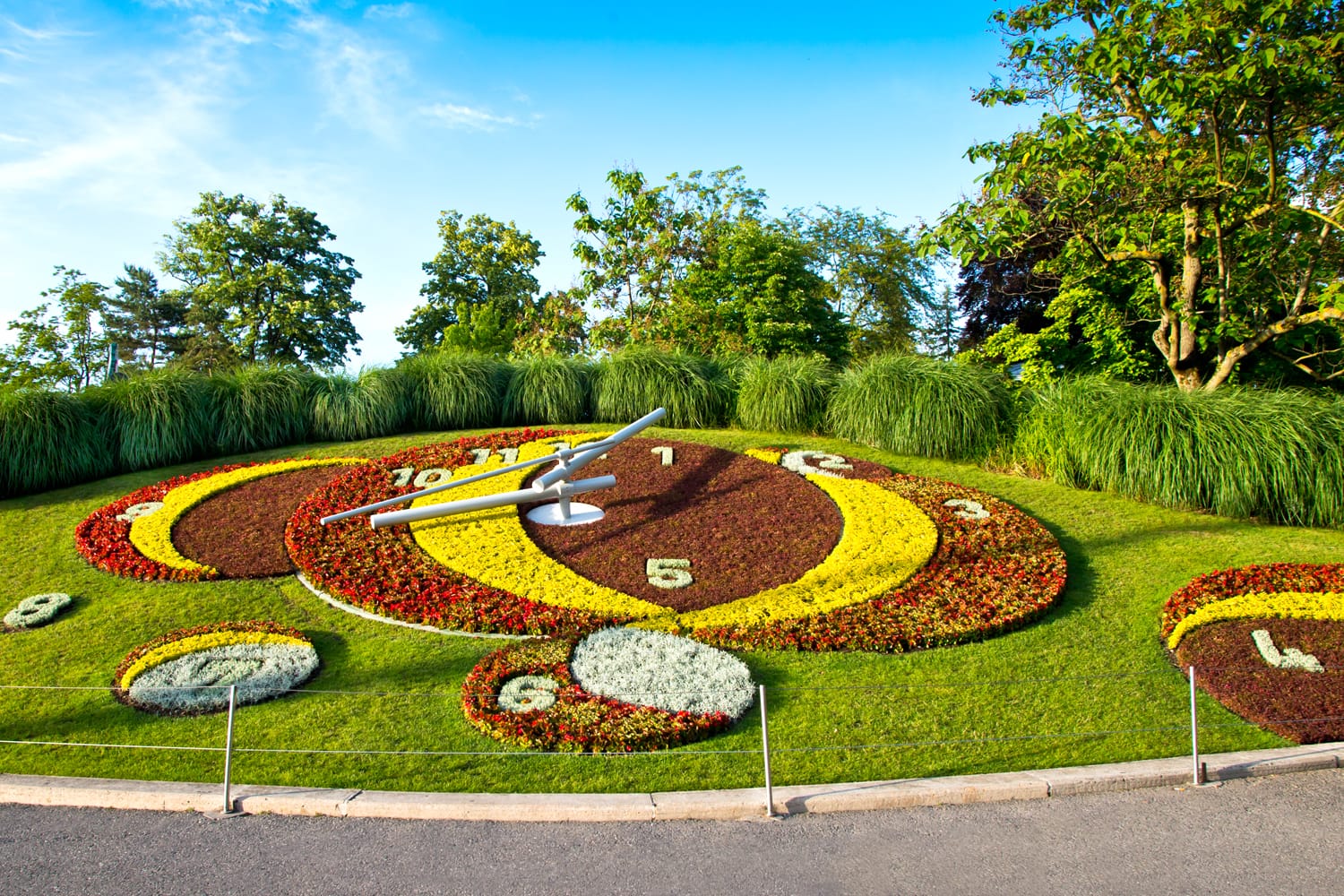
St. Pierre Cathedral
One of Geneva’s most noteworthy landmarks is St. Pierre Cathedral (also known as St. Peter’s Cathedral), which rests on a small hill in the heart of the Old Town. The striking Neoclassical facade from the 18th century belies the fact that most of the cathedral was built in the 12th century in a Gothic style.
Although this spot has been home to churches since the fourth century, most talk surrounding the cathedral focuses on its relationship with famed reformer John Calvin. You can see his personal chair inside the church, which he attended from 1541 to his death in 1564. You can even go down into the crypt to see the remains of an ancient basilica or climb the church’s towers for stunning views.
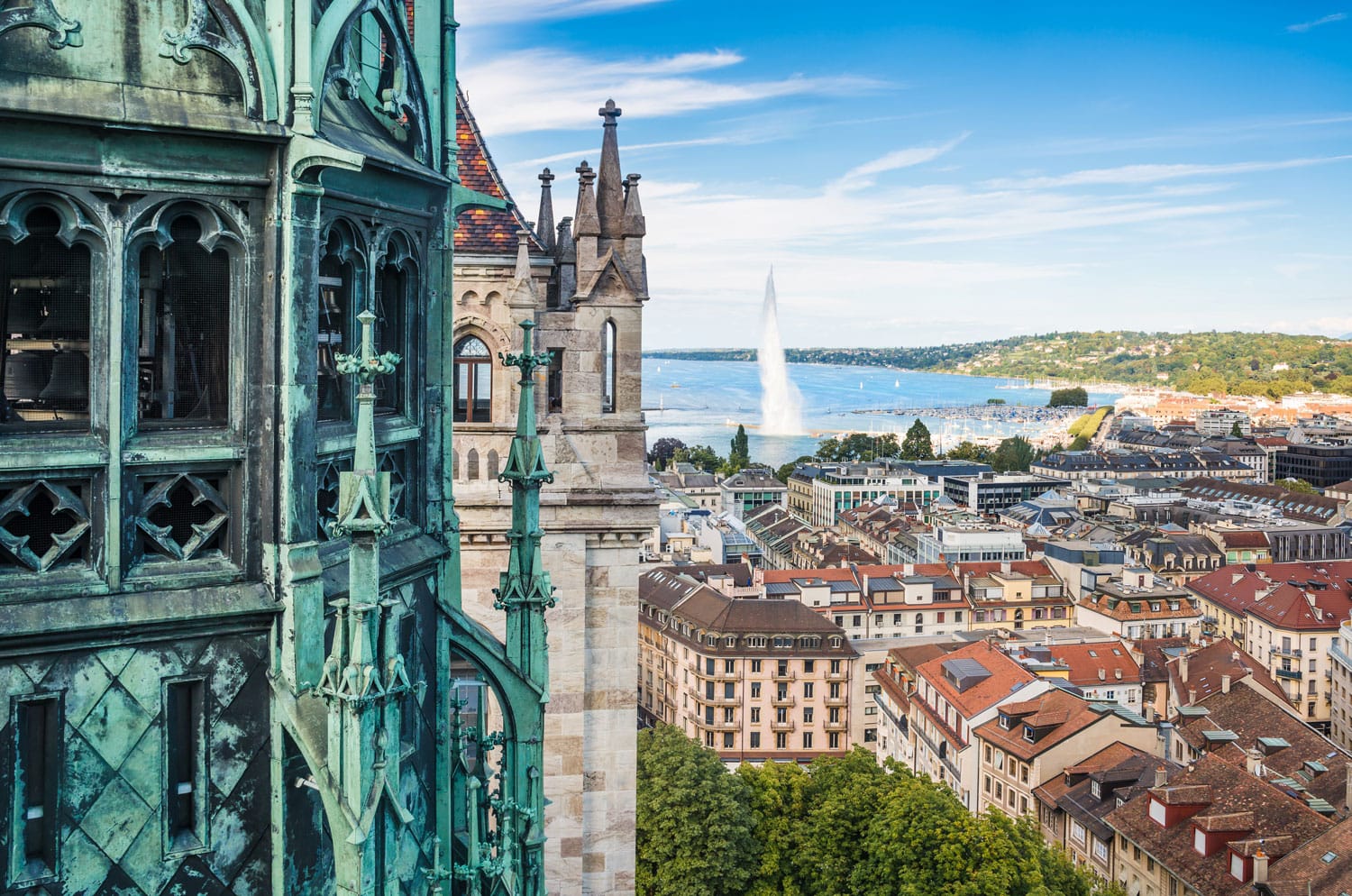
Maison Tavel
A short walk from the cathedral is Maison Tavel, a historic home that’s now part of the Geneva Museum of Art and History. Following a windswept fire in 1334, the house was rebuilt in the 14th century and is now the oldest surviving private home in Geneva. With a tour of this traditional Swiss house, you can glimpse what it was like to live back then. The museum also covers elements of the city’s history and how it grew over time.
Place du Bourg-de-Four
To see the beating heart of the Old Town, head for Place du Bourg-de-Four. This square is the oldest in Geneva and where an ancient Roman marketplace once stood. Lining this pleasant plaza are wonderfully quaint houses that now host charming restaurants and cafes.
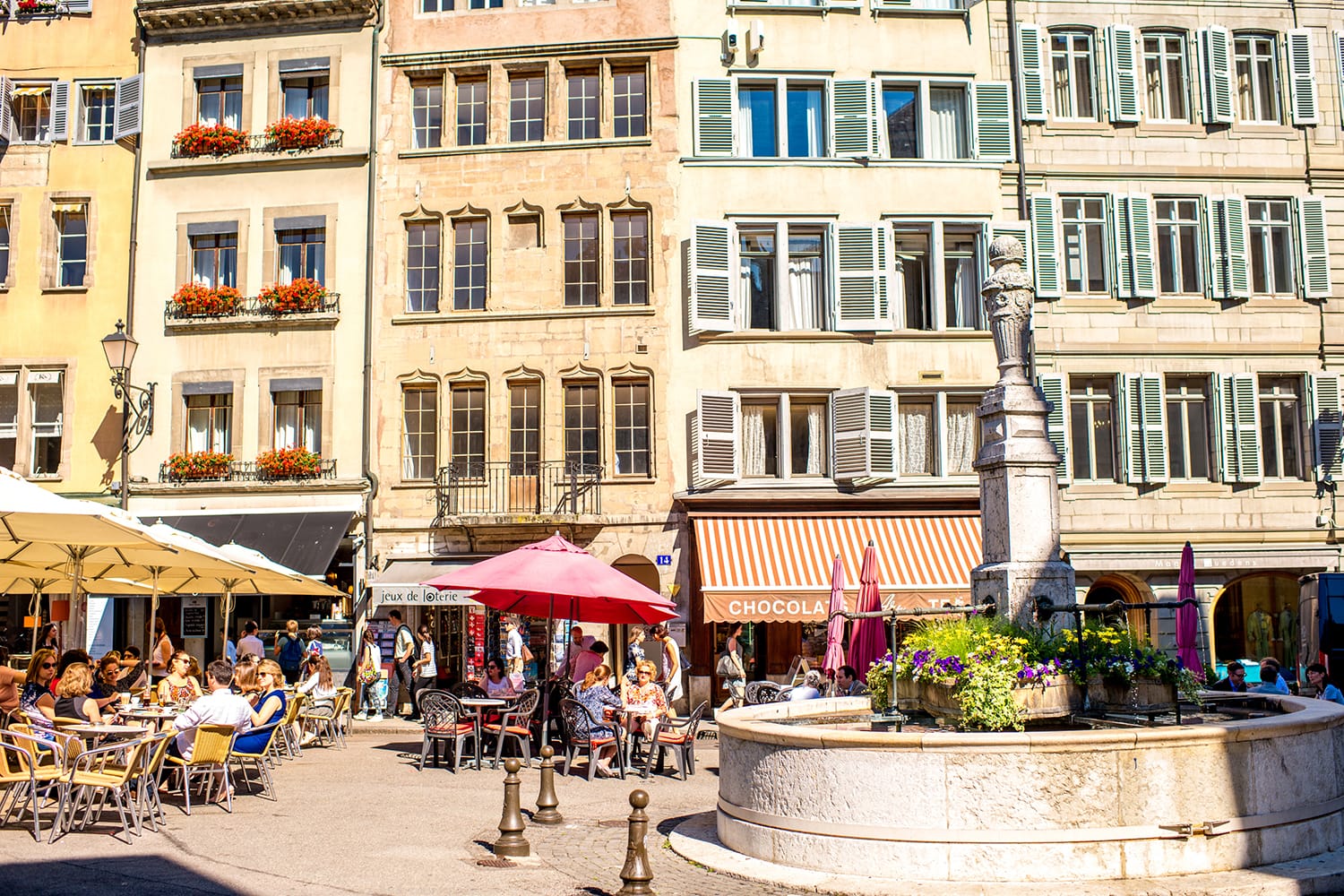
Reformation Wall
Resting along the southwestern edge of the Old Town is the Parc des Bastions, where you’ll find your next stop. At first glance, you might expect this landmark to be a war memorial, not deeply tied to local religious views. However, this large stone monument is dedicated to the Protestant Reformation and key figures in its development, such as John Calvin. The Reformation Wall and its looming sculptures were installed against the 16th-century city walls in 1909, before the space became a park.
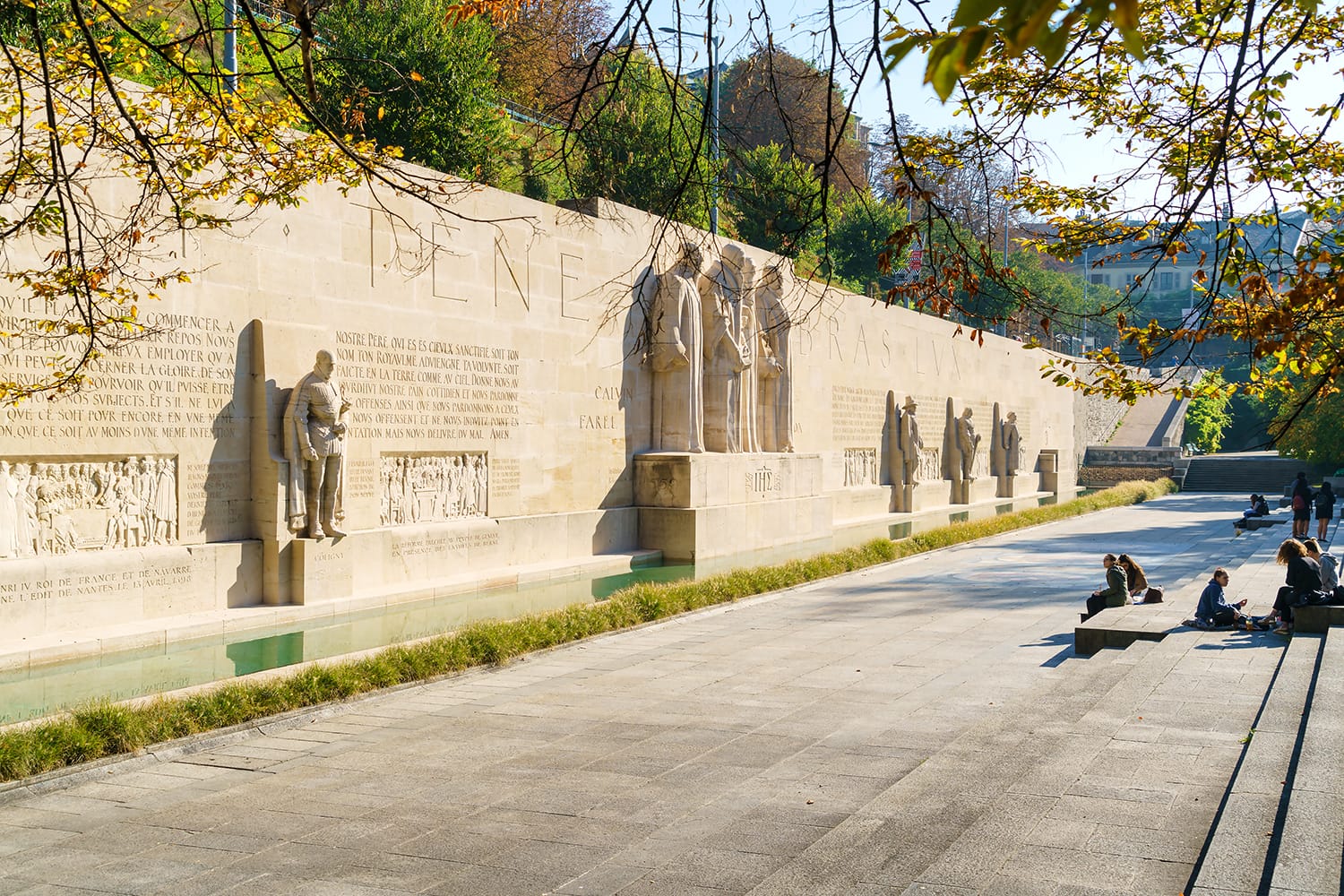
Art and History Museum
As a major international city and cultural hub, Geneva is home to countless museums. One of its best is the Geneva Museum of Art and History on the edge of the Old Town. Though it does strongly focus on Swiss art, the museum’s exhibitions also feature international pieces from big names like Rembrandt and Paul Cézanne. Beyond fine art, the museum has quite an impressive archaeology collection, which includes an Egyptian mummy and classical antiquity statues.
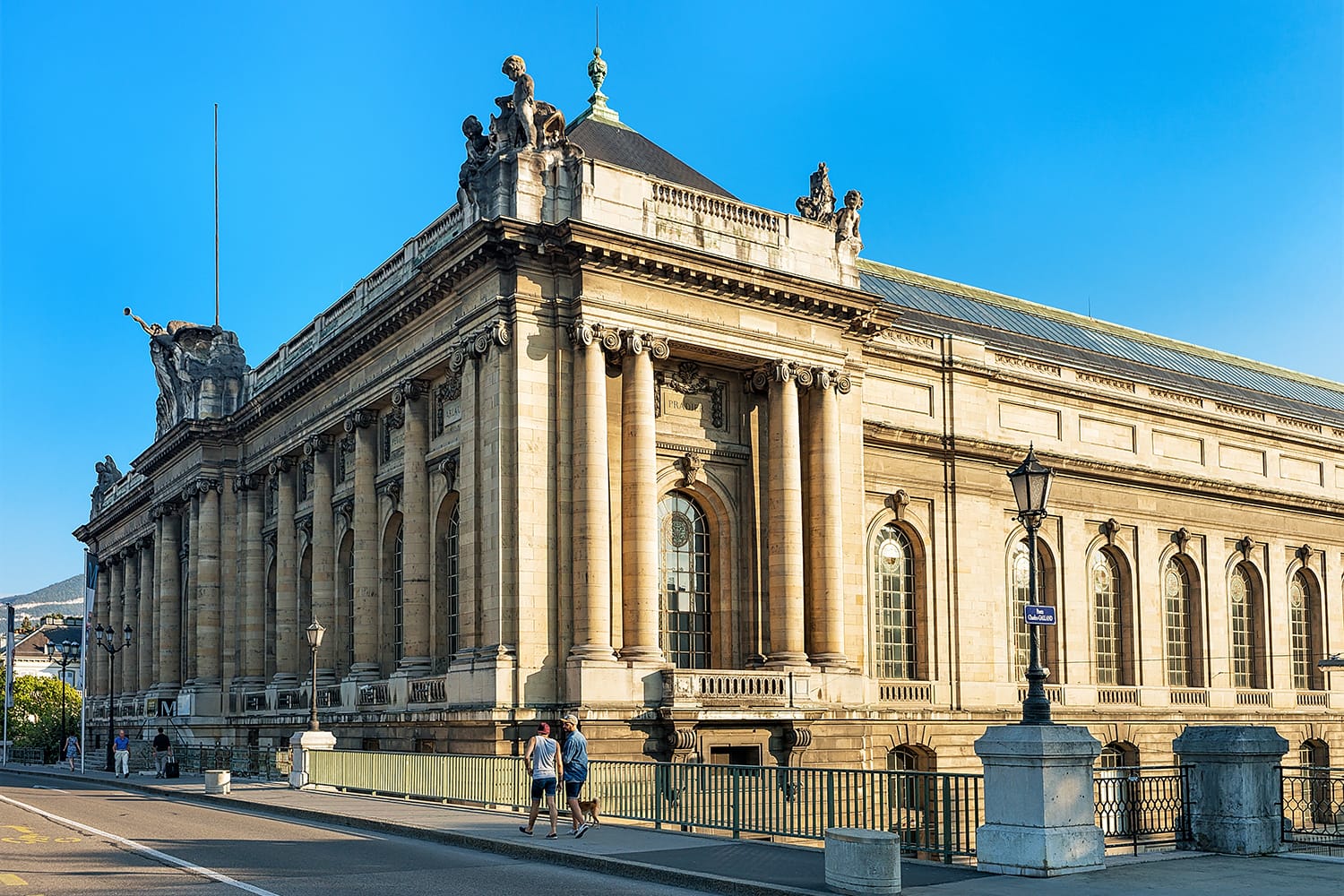
Jet d’Eau
Finally, head down to Geneva’s waterfront to see the towering Jet d’Eau. This mighty fountain is one of the city’s most famous landmarks, with water jets spurting 140 meters high. The best spot from which to admire this powerful sight is the Promenade du Lac, which runs along the south side of the lake. To get even closer, take a Mouette taxi boat from one bank to the other.
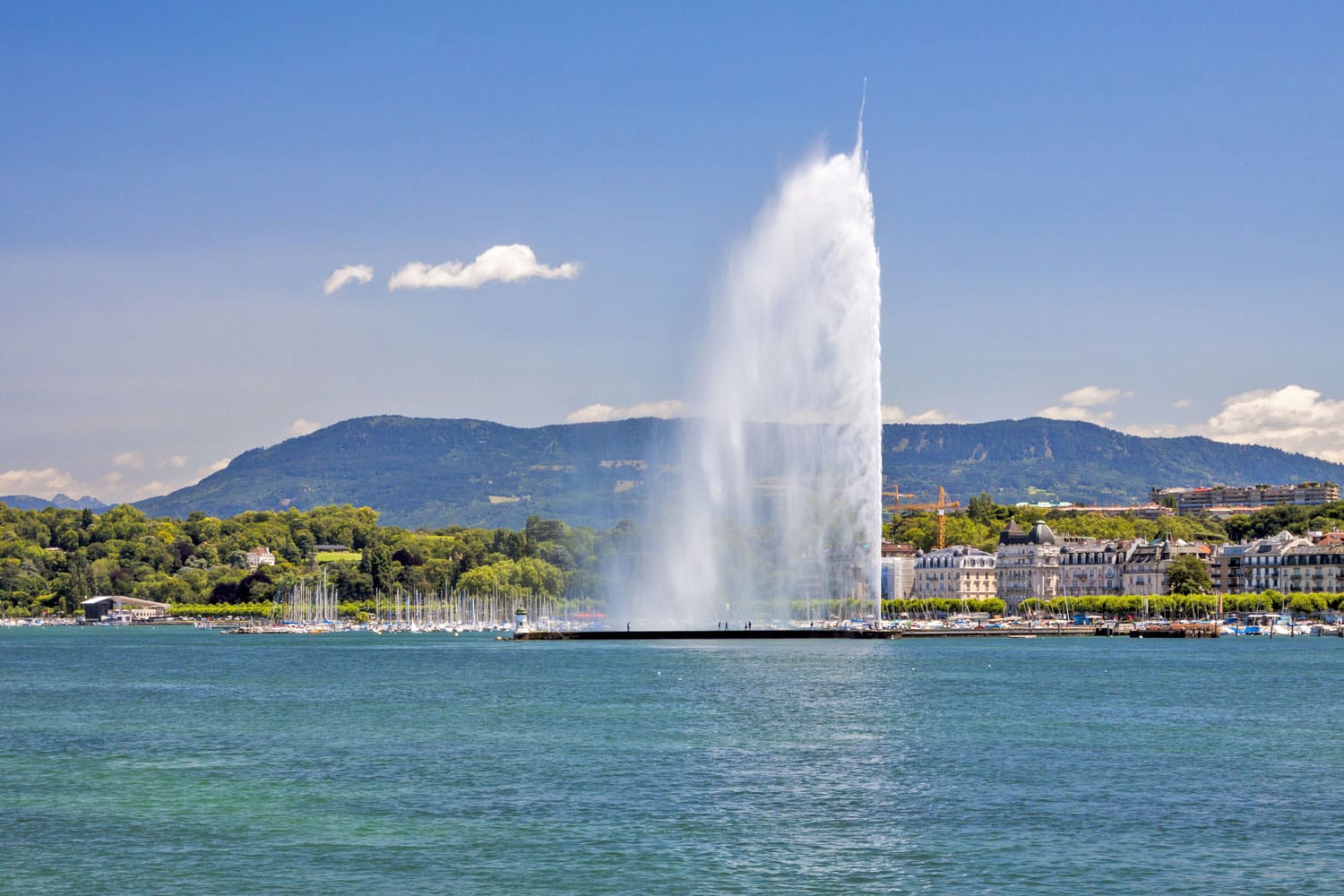
Day 2 in Geneva
Having covered the obvious attractions in the Old Town, you now get to widen your gaze and see what else Geneva has in store for you.
Brunswick Monument
Crossing the Rhône River and following Geneva’s lakefront north, you’ll soon reach the elaborate Brunswick Monument. Full of neo-Gothic detail, this mausoleum is a replica of the Scaliger family tomb in Verona, built for the Duke of Brunswick. Upon his death in 1873, the Duke’s fortune was given to the city of Geneva on the condition that he receive a grand funeral and a monument in his name. This landmark is the result of that vanity project, making for one of the stranger sights in Geneva.
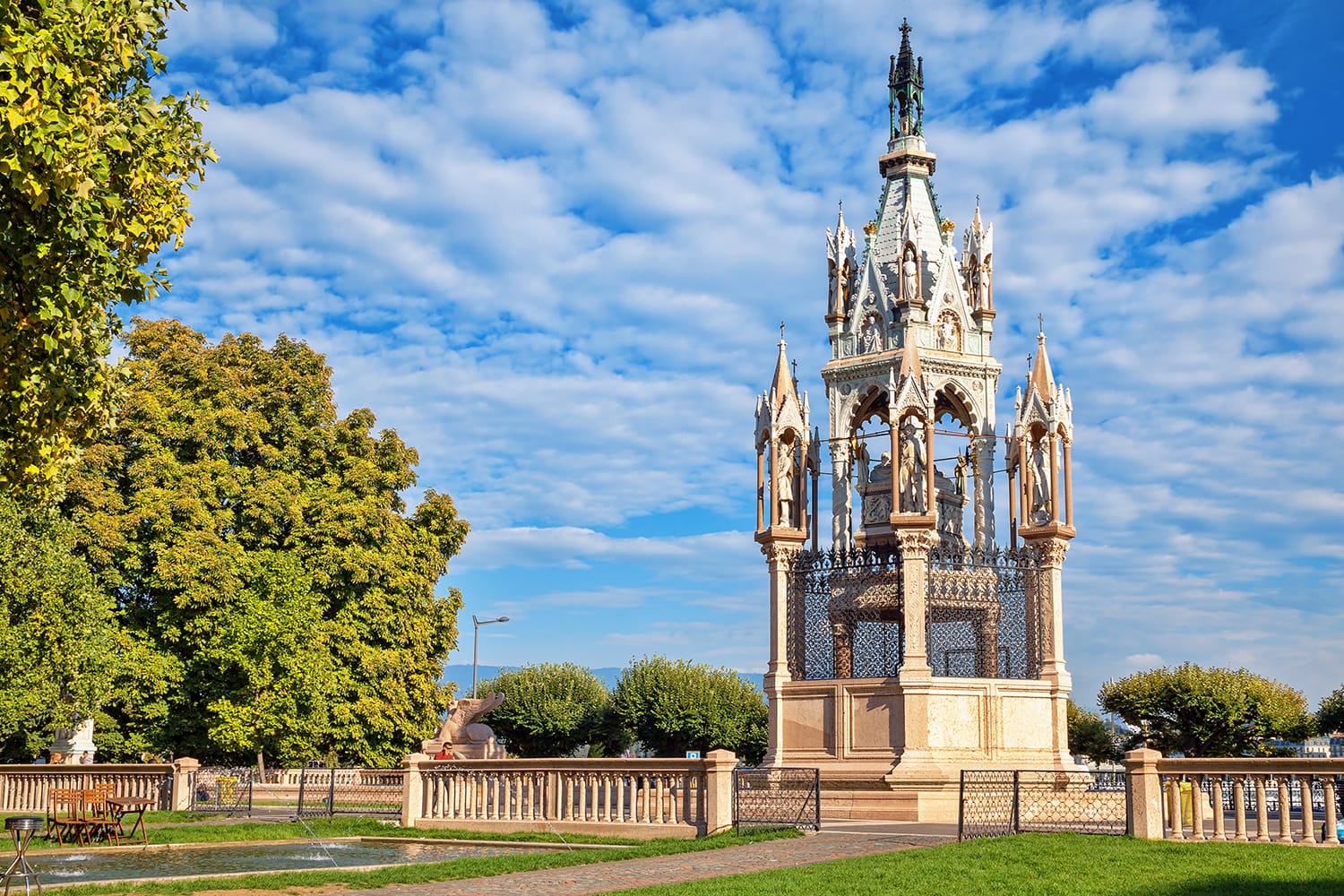
Palais des Nations
Thanks to Switzerland’s well-established neutrality, Geneva hosts a variety of international organizations and was a natural choice for the European headquarters of the U.N. You can take a guided tour through the U.N. offices in the Palais des Nations (or Palace of Nations), where you’ll see various rooms, halls, and chambers based on the tour schedule of the day. You can book a guided tour, which also includes a tour of the old town, here.
Outside the Palais des Nations, you’ll see the Broken Chair. Standing on three legs, this large piece of modern art protests the use of land mines and cluster bombs, providing a reminder of their lasting damage.
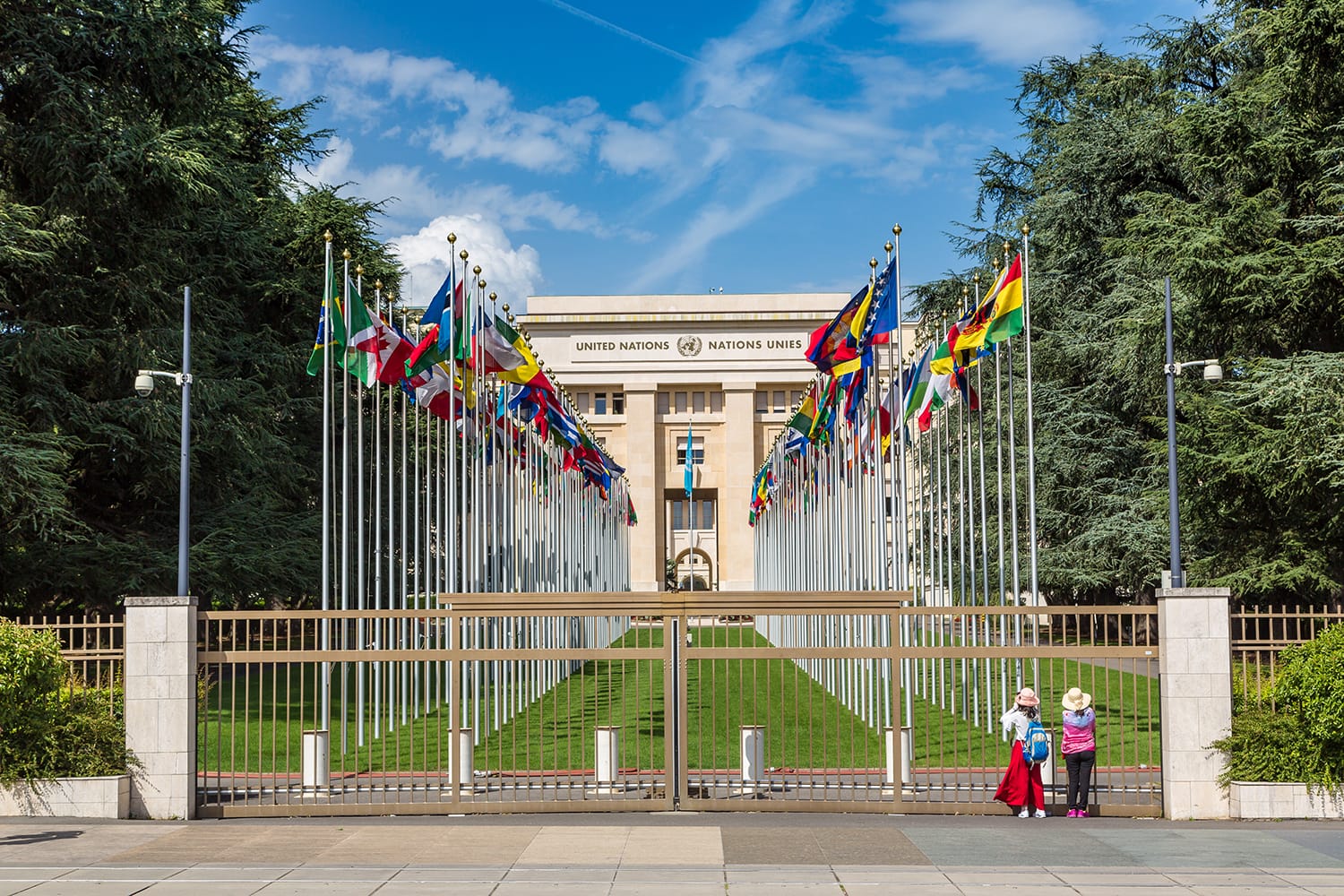
Quartier des Grottes
Returning to the city center, head for Les Grottes near Geneva Cornavin Station. This dense neighborhood had quite a rough reputation back in the ’60s, but it’s gone through various phases since, including a recent wave of gentrification. But it’s the architectural decisions of the ’80s that draw many people there today.
Adopting a colorful modern style similar to that of Gaudí throughout Barcelona, the buildings are an unexpected sight in a city like Geneva. They center on a building known as Les Schtroumpfs (the French name for the Smurfs), the most famous of these unconventionally fascinating buildings.
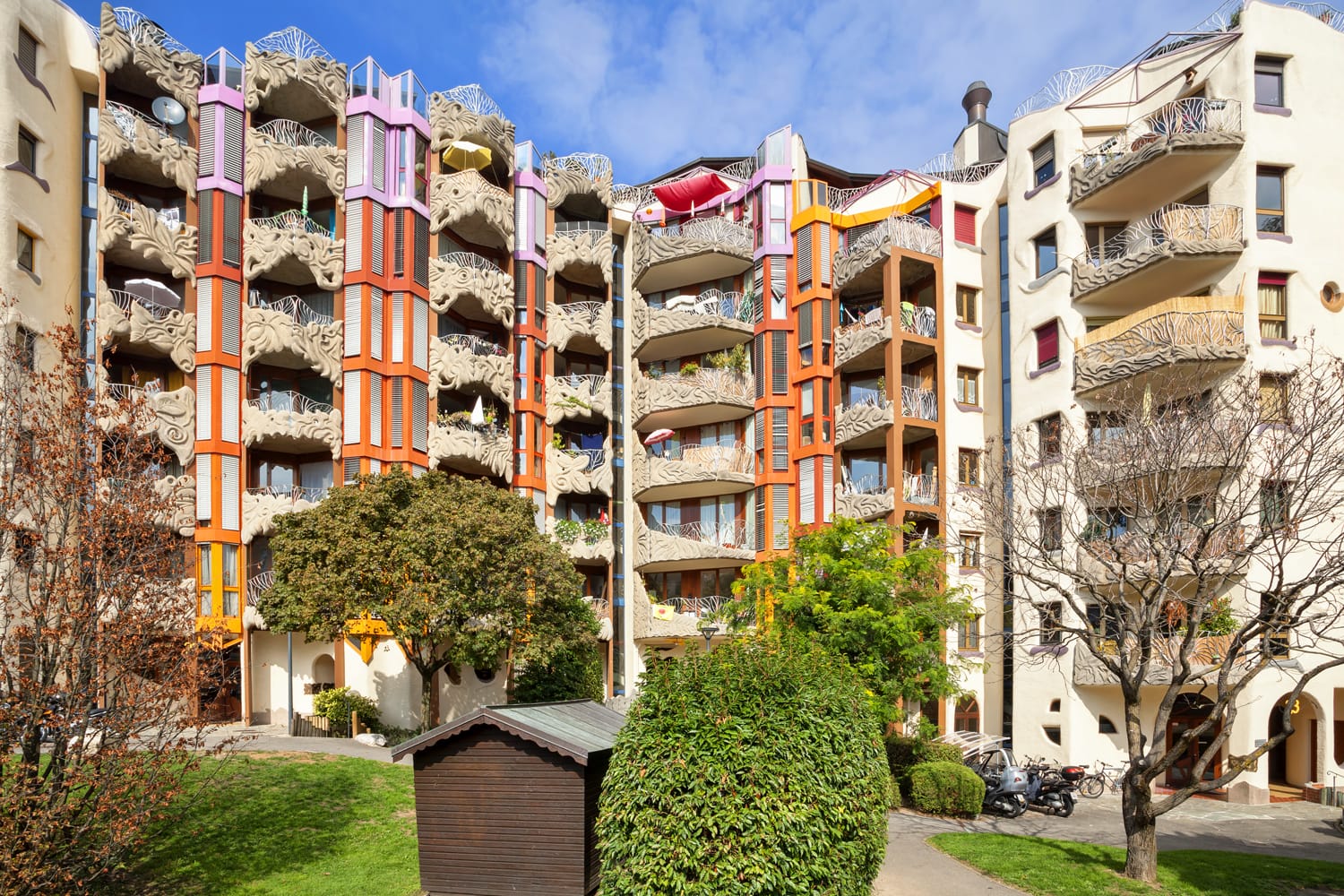
CERN
Next, you’re off to see another major international organization that calls Geneva home – CERN. Found out in the suburbs, CERN is the laboratory for the European Council for Nuclear Research.
The institute is home to the Large Hadron Collider, the world’s largest and most powerful particle accelerator, which helps solve problems at the cutting edge of particle physics. You’ll get to learn all about it with a tour of the visitor center and museum there. Unfortunately, you can’t actually go down into the Large Hadron Collider, but you still get to see plenty of this world-renowned facility.
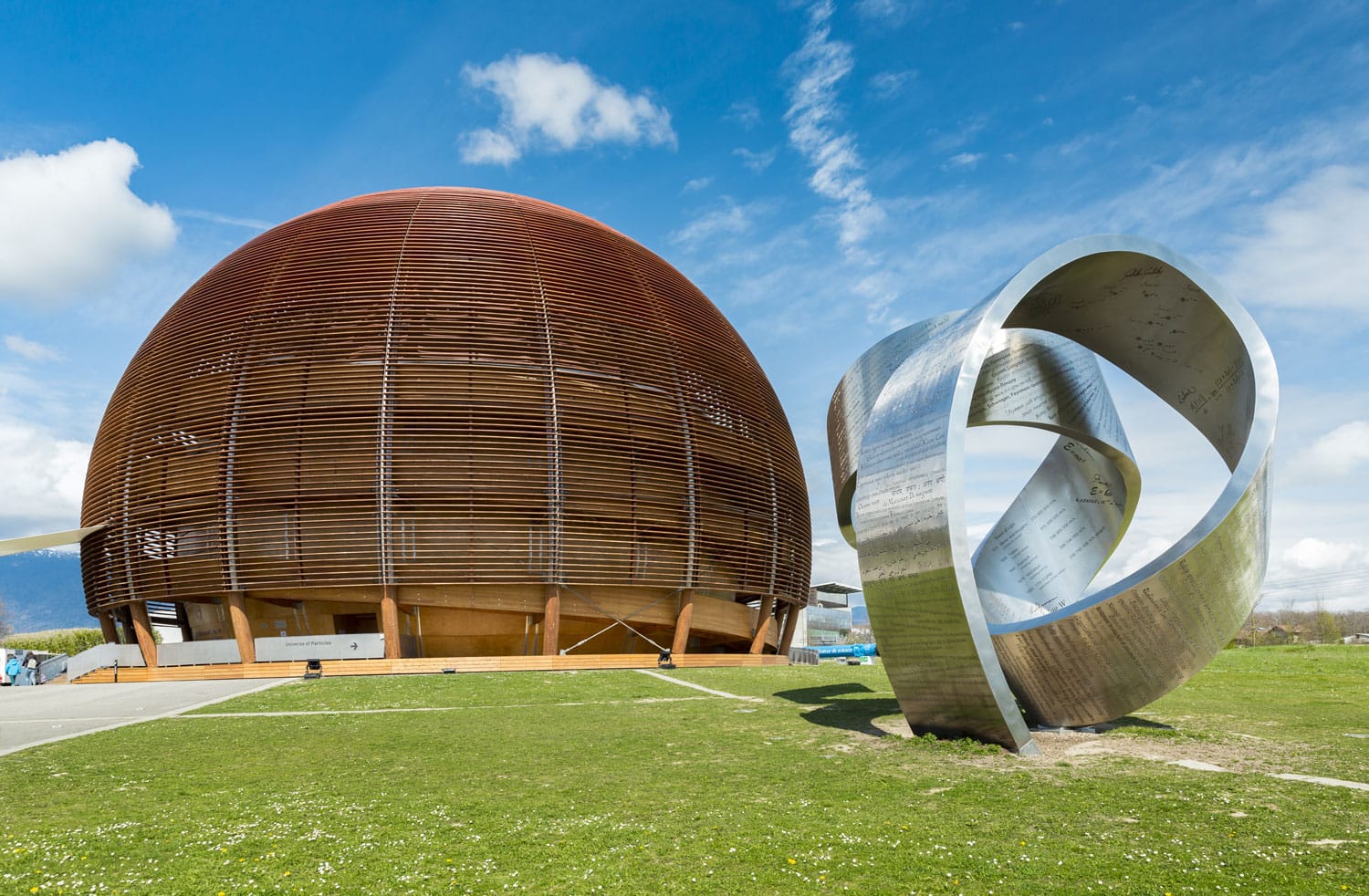
Carouge
As you continue hopping around Geneva, make your way to the neighborhood of Carouge south of the city center. Once a separate town heavily shaped by Italian influences, Carouge looks more like part of the Mediterranean than Geneva. This makes it a fascinating part of the city to explore, even before you get to the cafes, bookshops, and antique stores that line its traditional streets. In many ways, Carouge has become the bohemian quarter of Geneva, with its differences from the rest of the city lending it even more character.
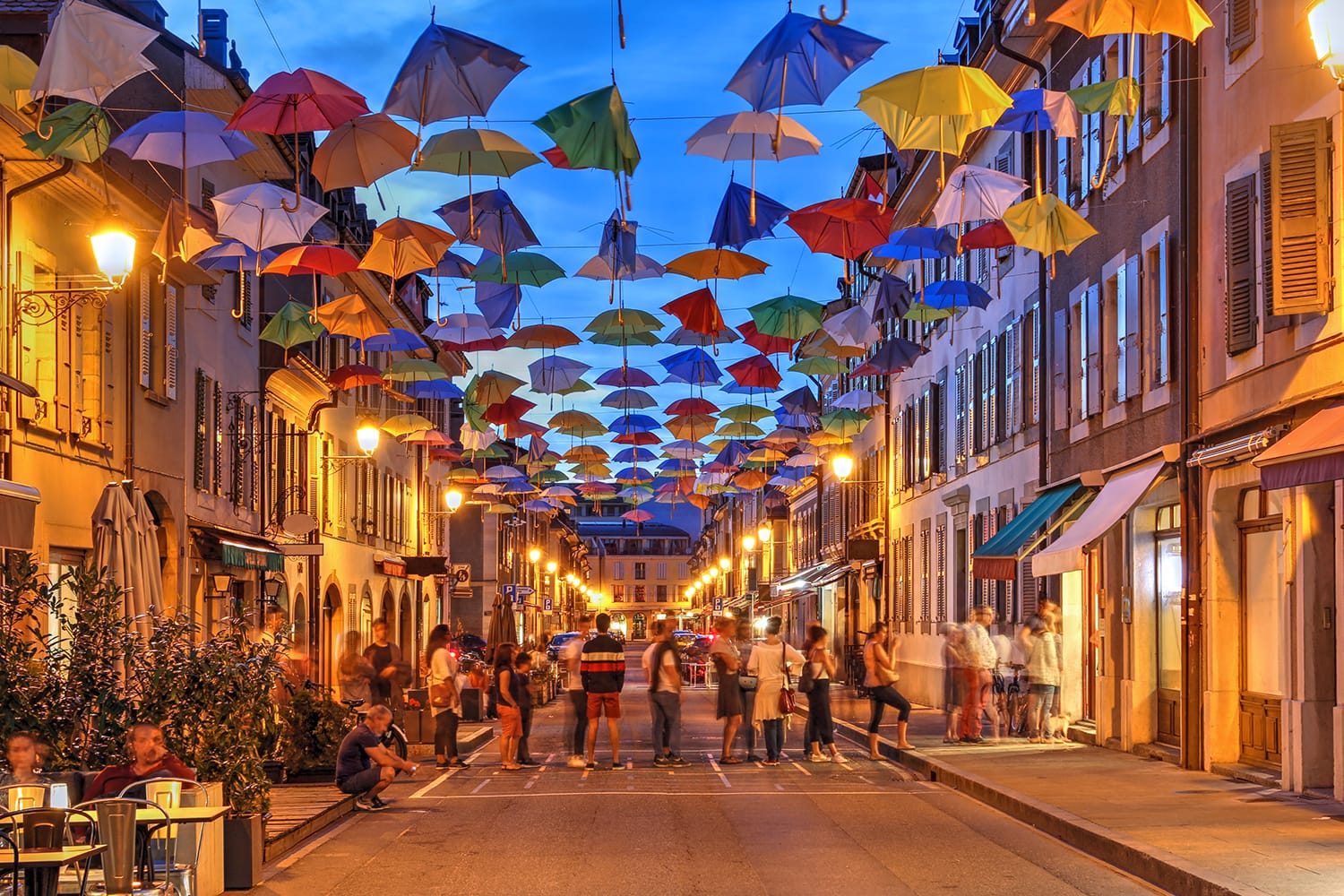
Mont Salève
For some wonderful views of Geneva to round out the day, make your way over the border to Mont Salève in France. This mountain reaches an altitude of 1,100 meters and enjoys sweeping views over Geneva, Lake Geneva, and the nearby Alps. To reach its panoramic viewpoints, take the Téléphérique du Salève, a cable car that leaves from just across the border. The ride takes just five minutes and will show you the city in a way you’ve yet to see it.
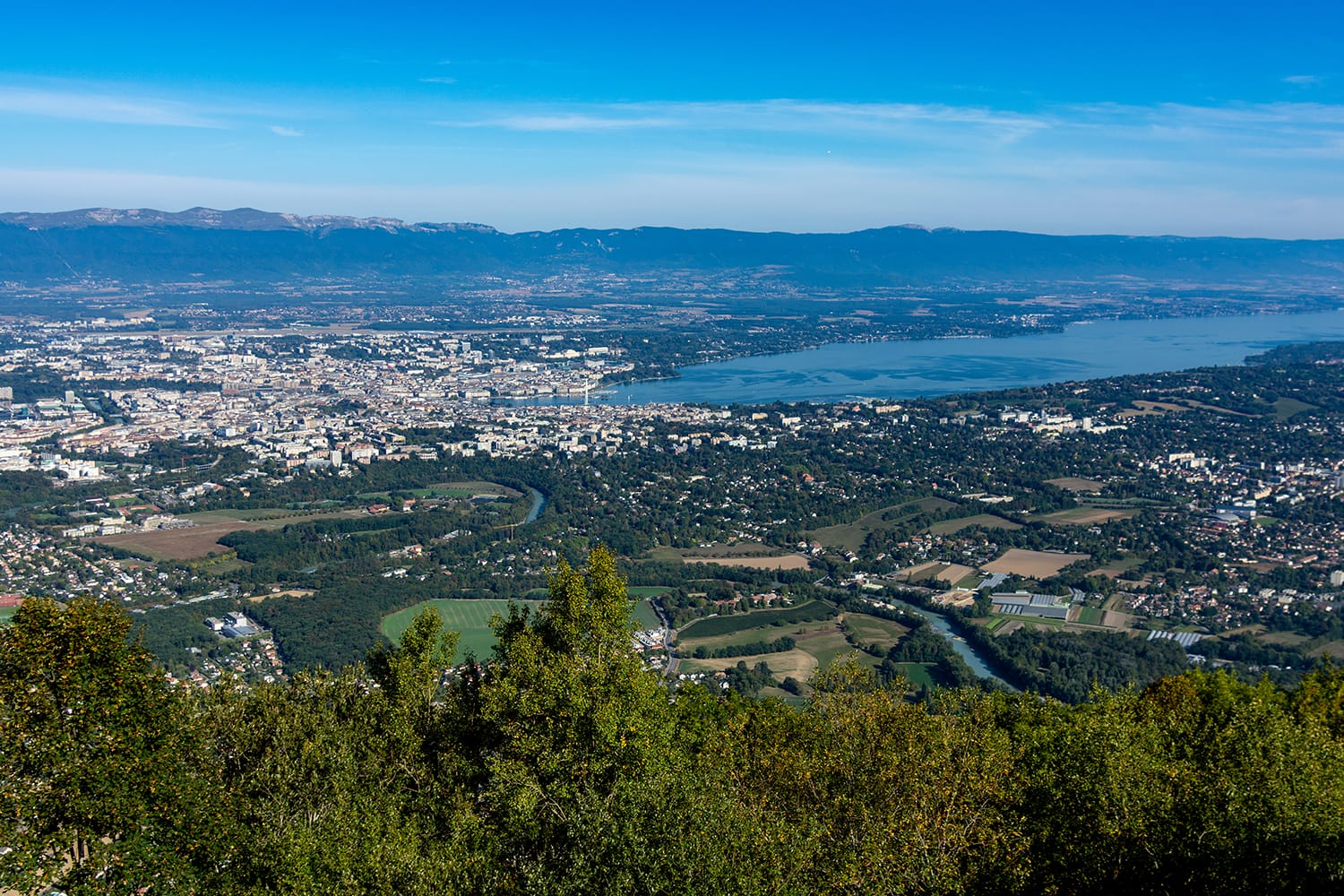
Day 3 in Geneva
With only a little of your 72 hours in Geneva remaining, there’s just enough time to see what other great destinations call this corner of Europe home. This day trip is an opportunity to see more of Switzerland or even some of France, given how close Geneva is to the French border.
1. Lausanne
Sharing the banks of Lake Geneva is the city of Lausanne, an excellent idea for a day trip from Geneva. Overlooking the lake and facing the Alps from its steep hillside, Lausanne goes all in on superb panoramic views, and the city itself has more than enough to keep you happily occupied for the day.
The Old Town of Lausanne is a natural starting point for exploring the city. Place de la Palud is a small square with lots of historic charm and just a short walk from the Escaliers du Marché, a covered wooden stairway that runs up through the area. These stairs will take you to the Cathedral of Lausanne and the Palais de Rumine, whose respective Gothic and Florentine Renaissance architecture are interesting to compare.
Lausanne is also quite a cultured city, boasting a great selection of museums. While Musée de l’Élysée is a more conventional museum with a vast photography collection, many visitors prioritize the Olympic Museum. Lausanne is the home of the International Olympic Committee, so you can learn all about the games and see special memorabilia at this museum.
For a more detailed look at this city, check out our comprehensive Lausanne itinerary.
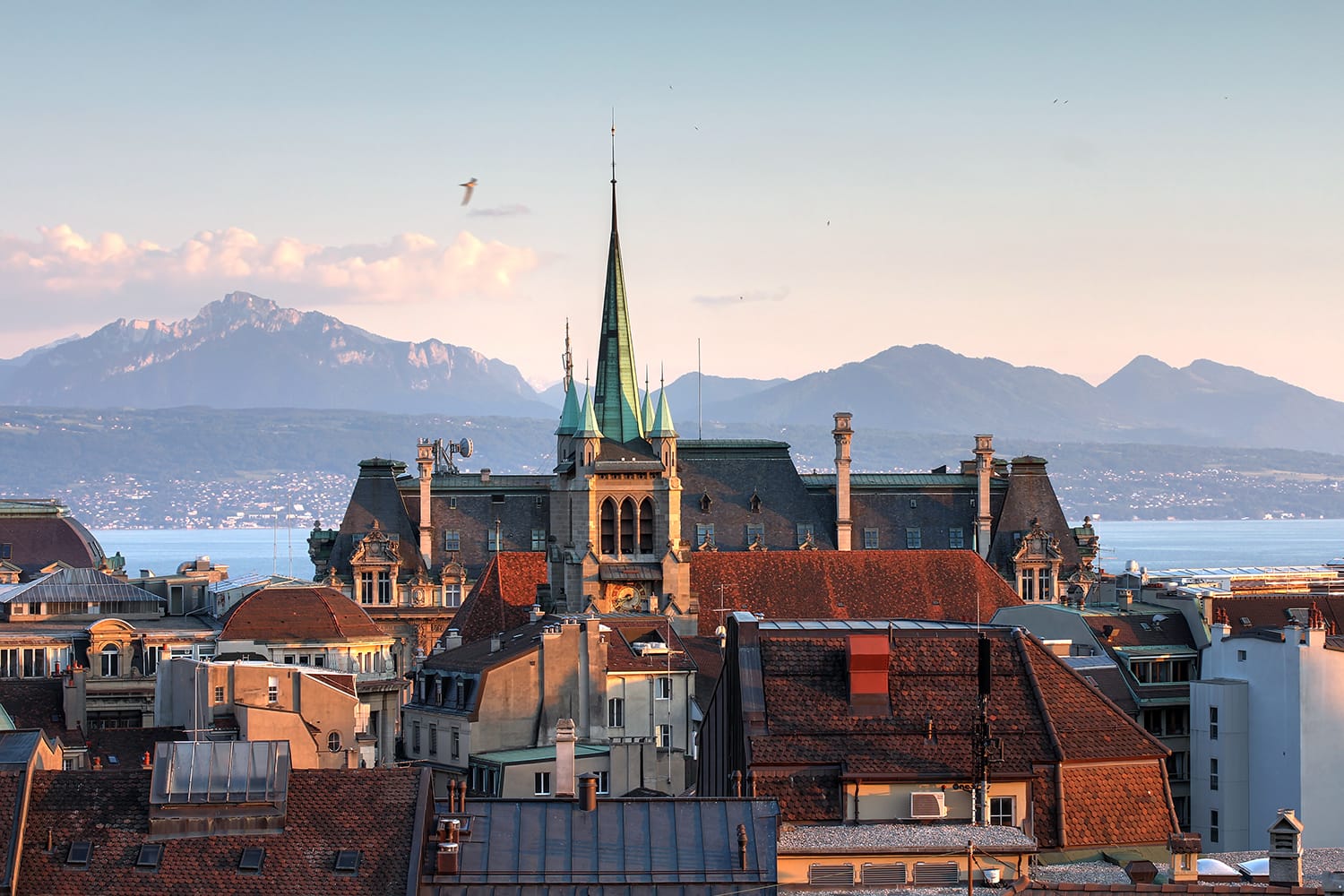
2. Swiss Riviera
Another popular place to visit along the shores of Lake Geneva is a group of destinations often known as the Swiss Riviera. Resting at the far end of the lake, these destinations boast an eclectic mix of attractions that ensure there’s something for everyone here.
It’s best to start your trip in Montreux, the largest town in these parts. Though it’s most famous for its international jazz festival, this resort town also boasts a scenic waterfront and Queen: The Studio Experience, a museum dedicated to the iconic rock band.
Take a nice walk along the lakefront to reach the magnificent Chillon Castle. This 10th-century castle is incredibly photogenic, earning it the title of the most visited historic monument in Switzerland.
The Swiss Riviera is the perfect place to go for a cruise on Lake Geneva, so hop aboard a ferry over to the resort town of Vevey, where you’ll find some brilliant Belle Époque hotels and lake views. From there, head up into the Lavaux Vineyard Terraces blanketing the hills of Lake Geneva. What better way to end the day trip than by wandering through beautiful vineyards with views of the Alps?
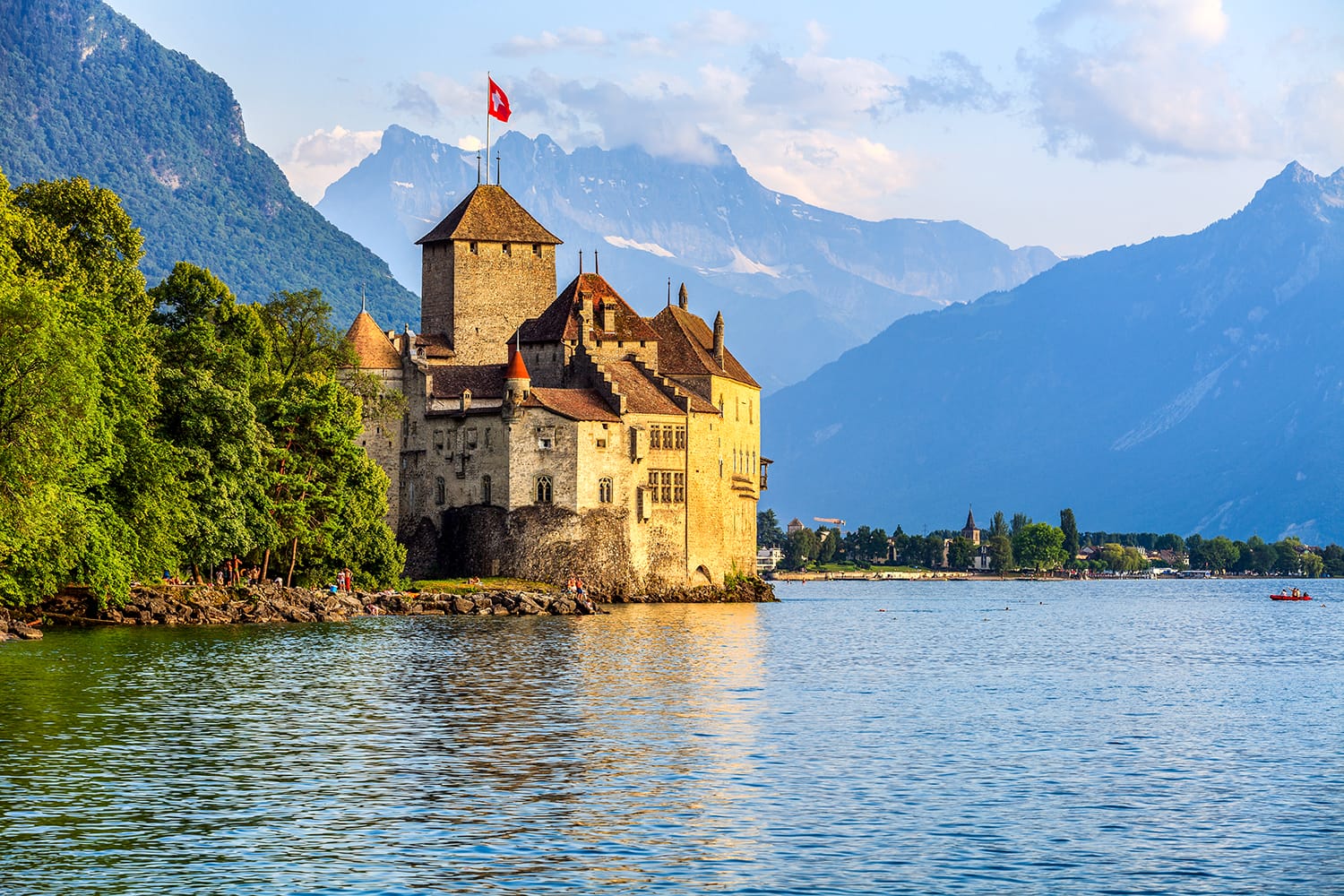
3. Annecy
As we said, potential day trips from Geneva aren’t limited to Switzerland, with one of the best taking you across the border to the French city of Annecy. This adorable Alpine city is known for its winning combination of old-town character and picturesque canals. Annecy is even nicknamed “the Venice of the Alps,” which should give you an idea of what lies in store for you there.
Begin your visit with the old town of Vieille Ville, where you’ll feel like you’ve gone back in time. Cobblestone streets and floral window boxes on pastel houses create wonderful medieval scenes that are a joy to wander. As you go, you’ll uncover tiny cafes, flea markets, and much more. Be sure to find your way to the Château d’Annecy, an art museum within a medieval castle.
It’s then time to witness the superb scenery of the city’s waterways. The Thiou River is responsible for some gorgeous shots, especially around the Palais de l’Île, a local history museum that was once a medieval castle and then a prison. Continue upriver to find the Jardins de l’Europe, a pretty garden park on the banks of Lake Annecy.
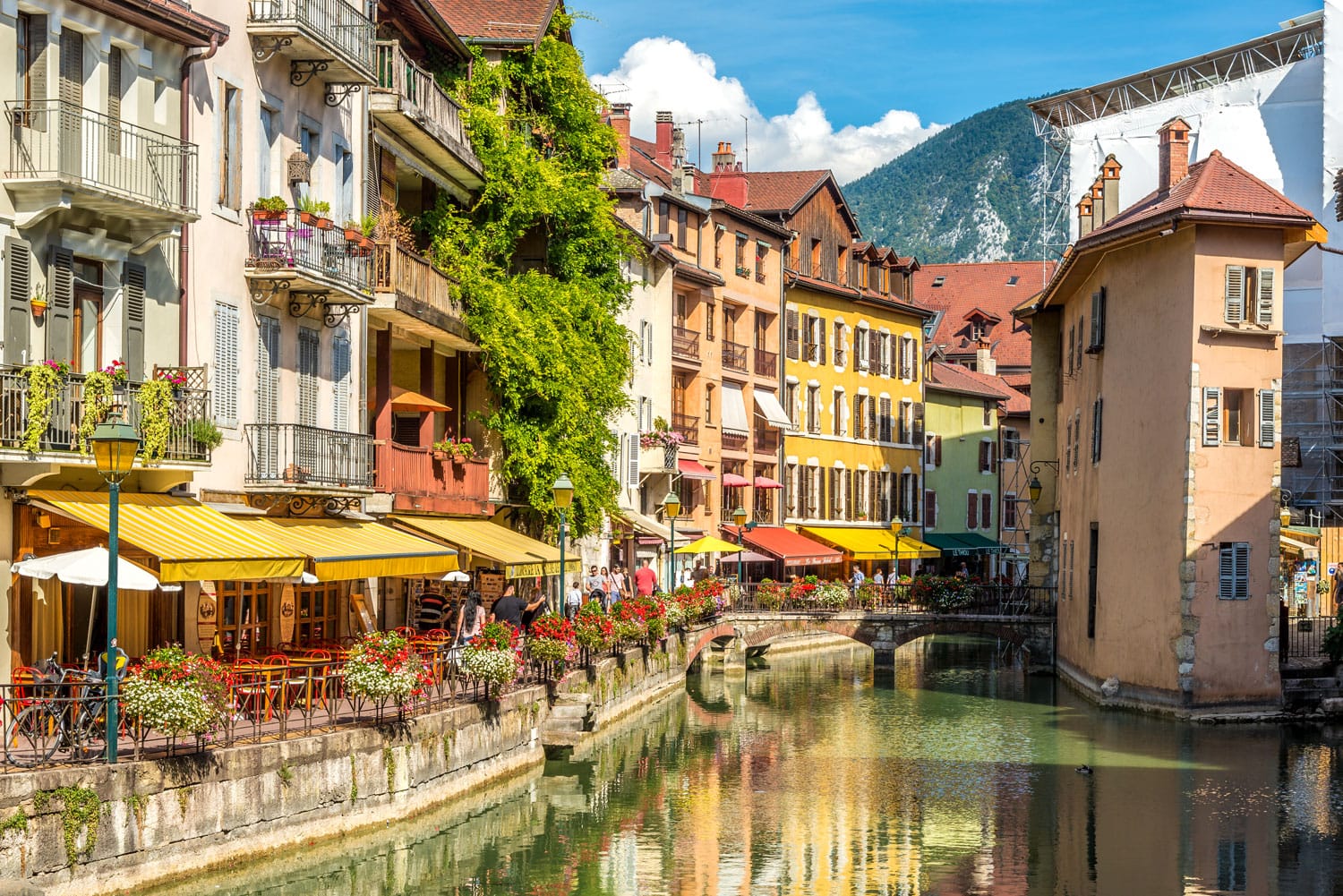
And there you have it – the ultimate Geneva itinerary with everything you need to know to comfortably explore Geneva in three days. With this information to help you plan your visit, you should have a solid idea of how to spend your time there. If you’re planning to travel more in Switzerland, also check out our guides to Zurich, Bern, and Lucerne.

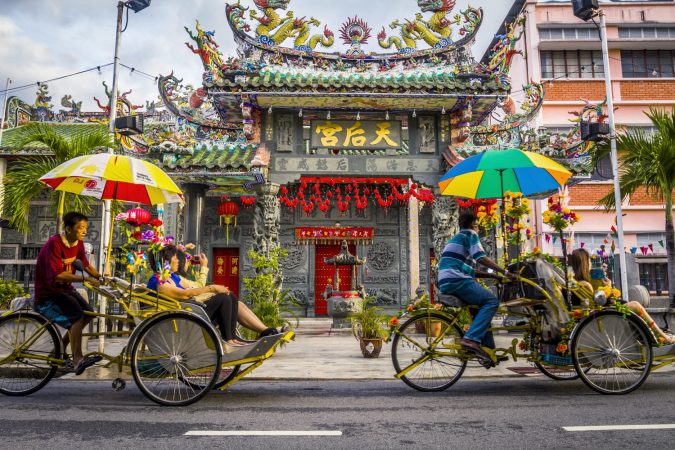
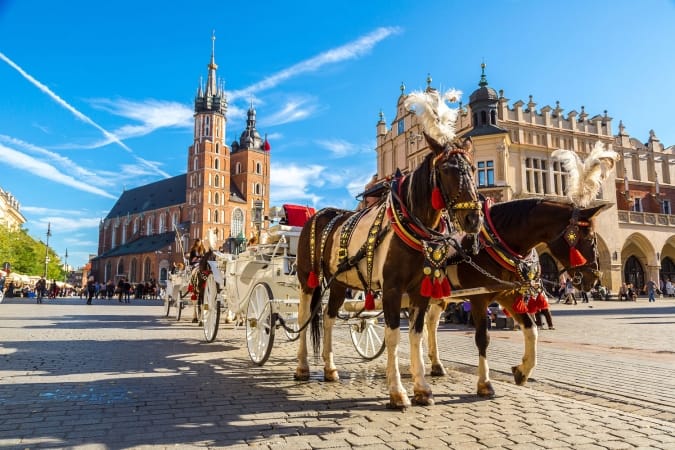
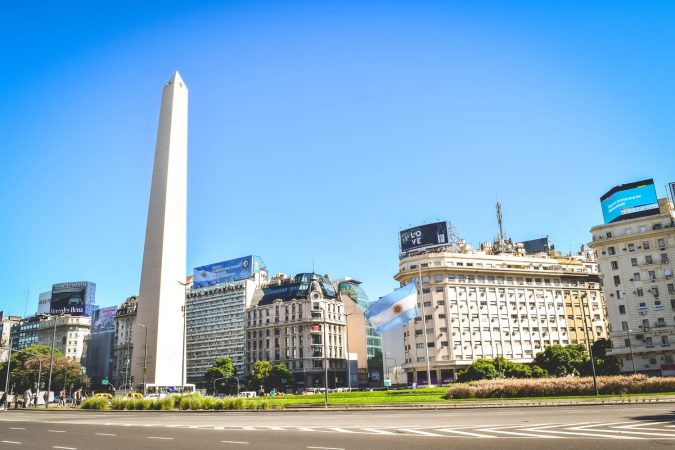
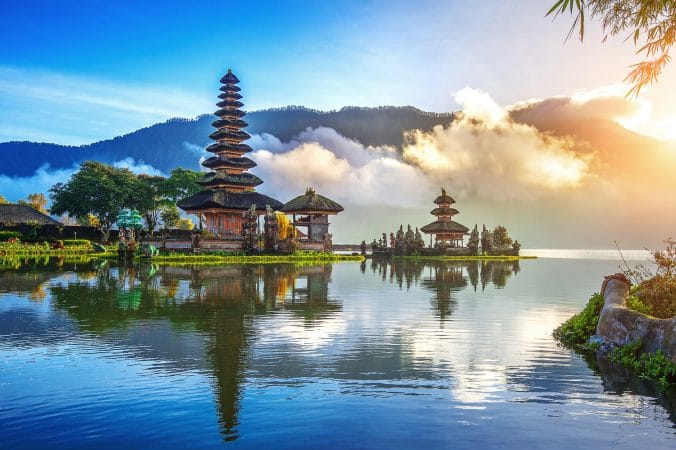
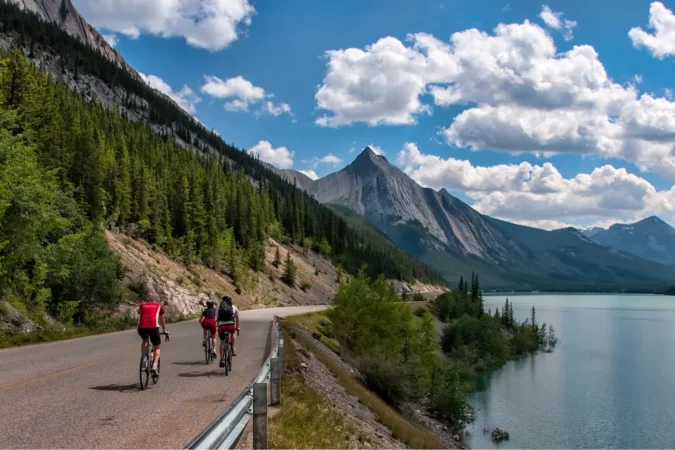
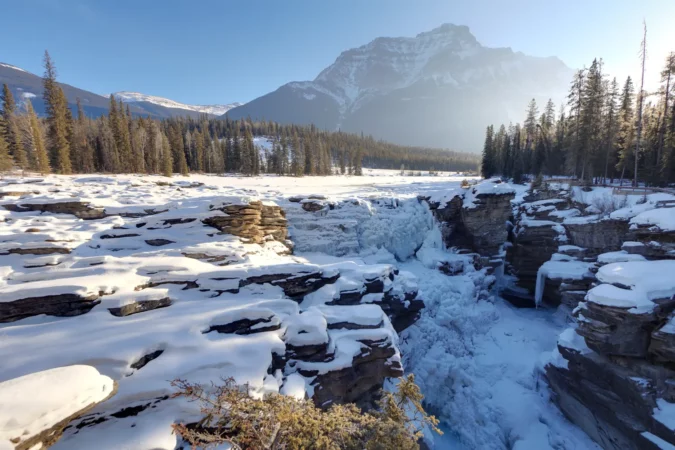
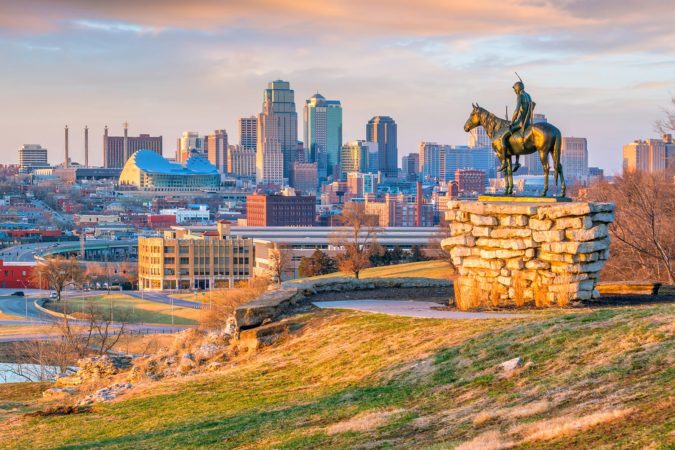
Comments